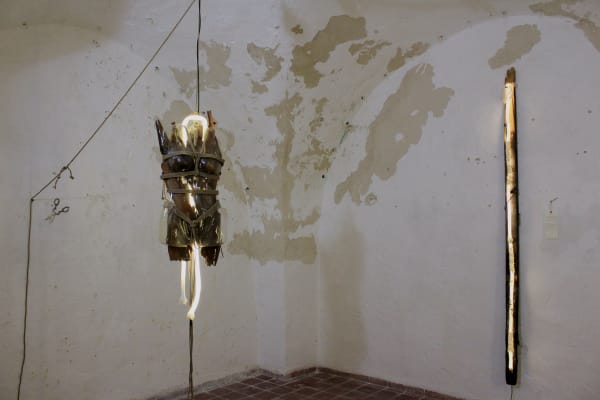Debi Oulu | Penetration
Omer Tiroche Gallery is proud to present a solo exhibition of the multi-disciplinary artist Debi Oulu. This exhibition will explore the relations of objects as human bodies and express Oulu’s emotions in a sharp and penetrating manner. The illuminated cable sculptures of Debi Oulu create a magical, fantastical world that differentiates between light and darkness, day and night, good and evil. This new series delves deeply into the philosophical concept of “the body”, and continues Oulu’s insightful artistic practice that she has presented until now.
Oulu’s artistic style is grounded in the soil of the physical earth and flies higher and higher into the spiritual realm. As God said “Let there be light…” and “God called the light Day…” are two sentences that constitute the cycle of life upon which our world is based. Oulu knows how to interpret this magical power into the creation of her illuminated bodies. The incandescent ropes become human bodies with masked faces and exposed souls; poetic angels hung from a meat hook in the ceiling. Sometimes they metamorphose beautifully into running water from a faucet, while other times changing into a thin vine that sprouts from an earthly vessel and climbs heavenly upward for judgement day.
The creation of light is the first order in the creation of the physical world. For the past decade, Oulu’s artworks have dealt with the human body and its function – physiologically, socially and politically within our society. Oulu has dedicated her body and soul to conveying her thoughts and desires. Sharp and penetrating, this new series of sculptures clearly express her emotions. ‘Moti’, 2016, one of the most sublime sculptures in the exhibition has an illuminated cable swirling in and out of a burnt wooden structure salvaged from a bonfire. In the artwork, Oulu confronts “The Hidden Light”, a term which is spoken about in Kabbalah. If man was created as a tool to receive the divine code, the illuminated cable is its means from which to receive it. In Haviva Pedaya’s essay, “Light as Internal and Light as a Sheath “, she says that we can experience reality as a space where physical light exists. This is in fact what Debi Oulu creates in her remarkable piece ‘Madeline’, 2016, in which a person must physically rejuvenate the light by peddling the bicycle.
Oulu’s “additions” of earthly found objects, intertwined with the illuminating cables, and are an integral part of her new three dimensional creations. She uses the same symbolism and allegories with which we are familiar in literature and poetry. These “additions” build the essence of the luminosity from Hayim Nahman Bialik’s poetic language, which magnifies the sublime light of divine truth liberating man from the chains. The meaning of the light that we see deeply rooted in Debi Oulu’s white cables is, as Immanuel Kant explained, “the illuminated light from within the world of the beholder”.
Debi Oulu’s illuminated artworks correspond with a long list of great artists throughout history who have engaged in the sensory and physical aspects of light. Rembrandt portrayed the spiritual holiness of God through the manipulation of light and shadow; Caspar David Friedrich used light to described the mental state of his subjects. In present day, James Turrell uses carefully placed light installations that seem to posses their own mass and volume; Dan Flavin creates human lines using neon lights. Israeli artist, Belu Fainaru uses light to express his vision of connecting the holy and the profane, and Motti Mizrachi portrays the “Israeli Pioneer” through light bulbs. In a latent dialog with these artists, Debi Oulu faces these concepts with her illuminated cables, creating her own unique inner, world.















